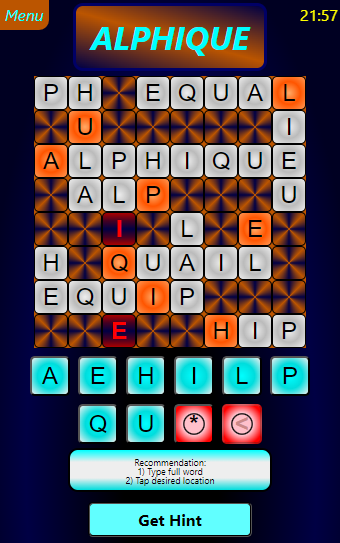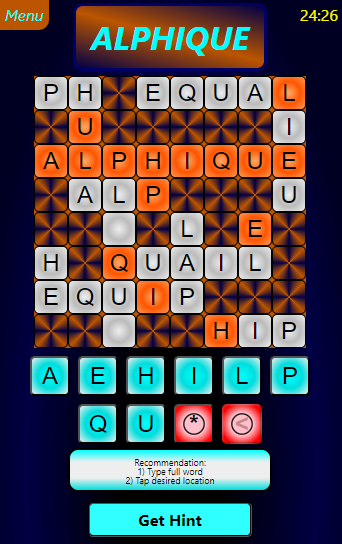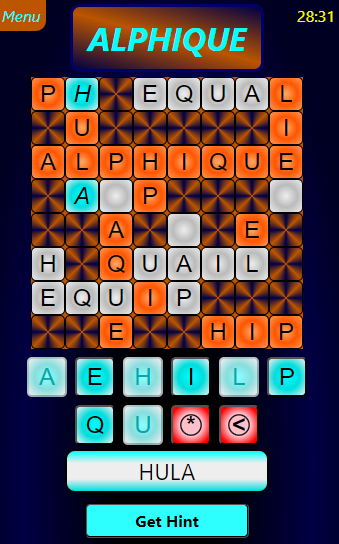Hints



- Validates letters (letters highlighted in orange)
- Validates words (letters highlighted in orange)
- Reveals a letter
- Good: Orange
- Bad: Red
- Suggests 3 or 4 letter word in puzzle
- Invalid words remember bad spots
- Invalid letters remember bad spots
Preferred Priority
- Incorrect Word Entries
- Incorrect letter entries
- Provide a random letter
- Suggest a 3 or 4 letter word hint
- Validate a word
Save Time, Use Hints
While there is a purist mentality of trying to not use hints, do yourself a favor and use them. It is incredibly difficult to solve Alphqiue puzzles without them. A puzzle should hopefully only take 5-15 minutes to solve, and if you don't take advantage of the hints, it could easily take a frustrating hour. This is supposed to be fun, not frustrating.
Hint Scoring
A hint given is the equivalent of 30 seconds of game play when it comes to scoring. A single hint may not feel like it does much, but a group of hints can start the ball rolling. Once a couple of larger words are discovered, things start to flow a little easier, so it's better to use them earlier rather than later.
Implicit Hint Knowledge
Based on the hint priority, there is implicit knowledge provided in the hints. If a hint suggests a 3 or 4 letter word or informs you of a letter on the board, that means nothing on the board is seen as incorrect. If you do not want to obtain new knowledge beyond what you have already entered into the board, you can select a previously entered word or letter. Then when you tap the Get Hint button, it will either turn the selection red for bad, or orange to lock in the correct letters.
Smart Word Validation
Whenever guessing decently large words that fit, it is recommended to use a hint. When near the maximum number of letters for a word, there often are not many words to choose them. For example, given a puzzle with 8 letters, there is typically only one 8 letter word, and zero to a handful of 7 letter words. However, there typically are a large number of 6 letter words. For example, compare the words "SILVER" and "SLIVER." On a fresh board, it is not hard to imagine that either one of those words would fit in the same spot. However, there are consequences to putting the wrong word in. Now the "I" and "L" will presumably be blocked for the wrong rows and columns. While the board will accept any solution in the list of valid acronyms, abbreviations, and words, a solution given a wrong decent sized word is unlikely. It is far better to use a hint and be told the word is wrong right away instead of after filling in 5 additional words and discovering that the last spot to fill in cannot be made valid.
Hints for Multiple Incorrect Entries
If there are multiple incorrect entries, a hint is only going to tell you about one of them at random. In this particular case, while you don't know what may be correct or incorrect, it is incredibly annoying to be told 5 different two letter entries are incorrect before being told the 5 letter word is incorrect. If it informs you a small word is wrong, it is recommended to start validating the larger words.
End Game Hints
Towards the end of a puzzle, hints become effectively useless. There may be a number of two letter words available, and a hint is going to only point you towards the primary solution. If there is a slot for a two letter word, and the first letter is an S, you could have so many options. SB: Antimony, SC: Scandium or South Carolina, SD: South Dakota, SE: South East or Selenium, SG: Seaborgium, SH: Shipping & Handling or noise for be quiet, SI: Silicon or System International (metric units), SM: Small or Samarium, SN: Tin, SO: conjunction, SR: Senior or Strontium, ST: Street, and SW: South west. Only one of these is going to be in the preferred solution that hints push towards, but the final solution will accept all of them. When they're actually interchangeable for a final solution, the hint means nothing.
Specific Hints
In a very convoluted way, it is possible to identify an unknown cell definitively, however it may take many hints to do so. You may tap a cell and see all the possible letters in the entry point. After placing a letter, you can verify whether it is correct or not.
Hint Timing
When first opening the board, there is a 15 second timer on using a hint. This time is meant to force you to study the board and not just immediately spam a bunch of hints. Afterwards, there is a hint cooldown between each successive use of hints to prevent solving by just spamming the hint button. However, we don't want you to be excessively punished for using hints. Therefore, the cooldown after applying the first hint is just one second. Each hint increases the cooldown by half a second. There is also a maximum cooldown on hints of 15 seconds. These numbers are subject to change, but this feels like a healthy balance to prevent abuse, make using a hint feel valuable, and not severely punishing for particularly difficult puzzles.